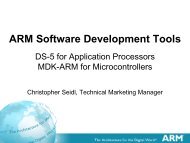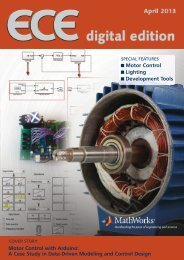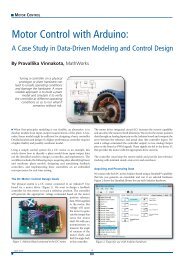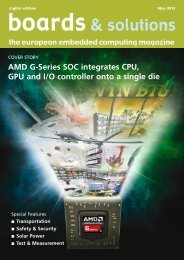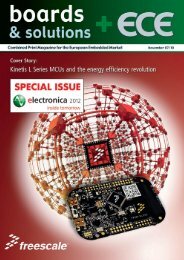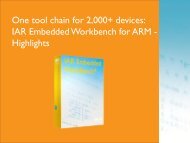CompactPCI Serial specification for modular embedded computer ...
CompactPCI Serial specification for modular embedded computer ...
CompactPCI Serial specification for modular embedded computer ...
Create successful ePaper yourself
Turn your PDF publications into a flip-book with our unique Google optimized e-Paper software.
COMPACTPCI<br />
Table 1. Cross-compatibility of system controllers and peripherals modules <strong>for</strong> the <strong>CompactPCI</strong><br />
range standards<br />
Table 2. Comparison of the <strong>CompactPCI</strong> <strong>Serial</strong> and VPX/OpenVPX technologies<br />
ferent control and supervisory complexes, and<br />
measuring equipment. And if the 3U systems<br />
are more suitable due to their capacity <strong>for</strong> execution<br />
of customer tasks, the 6U systems have,<br />
mainly, server functionality and designation.<br />
The VPX systems given the same size and<br />
computing parameters show at least twice the<br />
cost. Accordingly, their granularity in relation<br />
to cost is higher, which may lead in some cases<br />
to going over the limits of the permissible<br />
budget when creating a line of products.<br />
The ATCA standard-based systems have the<br />
biggest granularity – about 300W and the cost<br />
of modules about $50 to $8000. Thus it makes<br />
sense to use these systems <strong>for</strong> tasks with heavy<br />
loads on the switching or computing subsystems,<br />
measured in teraflops and tens of Gbit/s.<br />
The <strong>CompactPCI</strong> <strong>Serial</strong> standard supports different<br />
back-up and hot-swap technologies.<br />
The systems developers have all possibilities<br />
open <strong>for</strong> back-up implementation. For example,<br />
peripheral modules can be duplicated or triplicated,<br />
and the replacement of an inoperable<br />
module is possible without switching the sys-<br />
tem off (hot-swap). The full intrasystem duplication<br />
can be organized by synchronization<br />
of operation of two <strong>CompactPCI</strong> <strong>Serial</strong> segments<br />
through Ethernet channels (<strong>for</strong> the 3U<br />
and 6U systems), or using intrasystem switches<br />
(only <strong>for</strong> the 6U system).<br />
It will be fair to note that complete intrasystem<br />
back-up is rarely used nowadays. More often<br />
distributed back-up is applied, allowing to increase<br />
the systems operability with power supply<br />
from different sources and use of distributed<br />
communication lines. The high level of inter<strong>modular</strong><br />
switching and support of a large<br />
number of standard interfaces, such as Ethernet,<br />
is the key to success in creating systems with<br />
distributed back-up on the basis of the <strong>CompactPCI</strong><br />
<strong>Serial</strong> <strong>specification</strong>.<br />
Originally, the first <strong>CompactPCI</strong> standard was<br />
designed <strong>for</strong> use in the public telecommunication<br />
networks core. But since the end of the<br />
1990s telecommunication networks have<br />
changed a lot, and the switching capacity provided<br />
by the <strong>CompactPCI</strong> systems (1 to 2<br />
Gbps) became insufficient. Now their place in<br />
September 2012 30<br />
the public networks core is occupied by the 10<br />
to 40 Gbps ATCA systems and the rack-mount<br />
server-based solutions. But how about <strong>CompactPCI</strong><br />
<strong>Serial</strong>?<br />
With updated high values of the internal interconnects<br />
throughput capacity, the <strong>CompactPCI</strong><br />
<strong>Serial</strong> standard can be successfully<br />
used in the IP-based systems intended <strong>for</strong> creation<br />
of network infrastructure. But new possibilities<br />
<strong>for</strong> <strong>CompactPCI</strong> <strong>Serial</strong> now more<br />
likely exist not in the cores of public telecommunication<br />
networks, but in their peripheral<br />
and boundary sections. Regardless of the customer<br />
type, whether a digital house, digital<br />
transport, digital office or subscribers, the<br />
equipment <strong>for</strong> their network access should be<br />
able to recognize different wire and wireless<br />
data transfer protocols, to aggregate and convert<br />
these flows in TCP/IP and to carry out their<br />
preprocessing. The <strong>CompactPCI</strong> <strong>Serial</strong> capacity,<br />
competitive prices and low granularity values<br />
– this is a partial list of the advantages which<br />
play a key role here.<br />
If we have a look at a private network, <strong>for</strong> example<br />
at the process equipment control network<br />
or at the vehicle control network, the<br />
<strong>CompactPCI</strong> <strong>Serial</strong> system switching capacities<br />
allow its use <strong>for</strong> resolution of tasks in the core<br />
of such a private network. Already there are<br />
some successful applications, <strong>for</strong> example, the<br />
Wi-Fi Internet system in European trains.<br />
The possibilities of the 6U <strong>CompactPCI</strong> <strong>Serial</strong><br />
standard are also interesting <strong>for</strong> creating the<br />
wire network infrastructure connected with<br />
the support of technology of the customer devices<br />
power supply via the network cable<br />
(Power over Ethernet – PoE). Such devices include<br />
IP surveillance cameras, panel <strong>computer</strong>s,<br />
controllers and other devices, consuming up<br />
to 40W. By means of the P0/J0 connector, the<br />
6U <strong>CompactPCI</strong> <strong>Serial</strong> modules can be provided<br />
with an additional power supply of –<br />
48V via the motherboard, with maximum current<br />
of 1.9A (91.2W).<br />
The CPCI/VME standards have taken a strong<br />
position in many niche markets, such as production<br />
automation, complex process equipment<br />
and programmable-controlled machines<br />
management, control and communications<br />
on transport, defense systems and many others.<br />
The new <strong>CompactPCI</strong> <strong>Serial</strong> standard allows<br />
simplifying the system creation process. The<br />
system developer has the possibility to choose<br />
between 4 types of interconnects, allowing to<br />
reduce significantly the number of bridges <strong>for</strong><br />
communication of peripherals with the system<br />
controller. Direct connection of SATA drives,<br />
including the use of chipset-integrated RAID,<br />
connection of USB cryptokeys or controllers<br />
with USB ports, CompactFlash, SD and mi-



